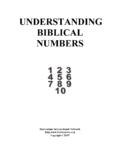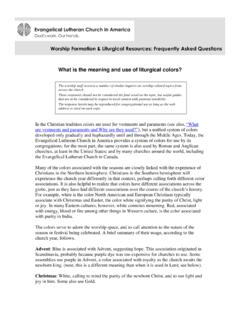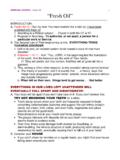Transcription of Fruits of the Bibles - Horticulture
1 Fruits of the BiblesJules JanickDepartment of Horticulture and Landscape Architecture, 625 Agriculture Mall Drive, Purdue University,West Lafayette, IN 47907-2010 Additional index , date, fig, grape, olive, pomegranateAbstract. The sacred writings of three religions (Judaism, Christianity, and Islam) are contained in the Hebrew bible (referred to by Christians as the Old Testament), the Christian bible (New Testament), and the Qur an (Koran). Thesewritings encompass events occurring over a period of more than two millennia and taken together represent a broad pictureof mideastern peoples, describing their interactions with the sweep of events of that era.
2 The writings include the sacred andprofane, prose and poetry, history and myth, legend and fable, love songs and proverbs, parables and revelations. The basicagricultural roots of desert people are infused in the texts. Plants, plant products, and agricultural technology are referredto in hundreds of verses. References to Fruits are abundant so that these Bibles can be read almost as a pomological text inaddition to the religious and sacred meanings that still inspire billions of plants of the Bibles have long been ofhistoric interest despite the many translationproblems.
3 The Hebrew bible was written inHebrew and Aramaic, translated into Greekin the second centuryBCE, and then constantlytranslated into all the languages of the world,but the precise species originally referred tois unknown in a number of cases. In 1556, theplants of the bible were specifically dealt within a book by Levinus Lemmes, and sub-sequently treated in a number of other 1952, the indefatigable husband and wifeteam of Harold N. and Alma L. Moldenkecompiled a treatise entitledPlants of theBible(Fig. 1A) that includes key mentionsof plants by chapter and verse, and assignedbinomials, from 53 books of the HebrewBible and 27 of the Christian bible (Autho-rized Version).
4 This is a valuable source bookfor any study of biblical horticultural. TheMoldenkes (Moldenke and Moldenke, 1952)refer to 230 species fromAcacia niloticatoZostera marina. They also provide chapterand verse for general references for which noparticular plant can be identified, such as fruit (most common), herb, thicket, tree, grass, andforest. The Moldenkes cite only the mostimportant or interesting verses (Moldenkeand Moldenke, 1952), but nevertheless, thenumber of chapters cited gives some idea ofthe prominence of each fruit (Table 1); grapeis clearly the most significant fruit of of the best sources of information onbiblical Fruits is the impressive work ofAsaph Goor and Max Nurock (1968) entitledThe Fruits of the Holy Land(Fig.)
5 1B). Thiswork not only covers the canonical texts ofthe Hebrew and Christian Bibles , but alsoincludes postbiblical Jewish commentariesincluding theMishna(ca. 300CE) andTalmud(ca. 600CE). Fruits covered include grape,olive, fig, date, pomegranate, almond (thechief biblical Fruits ); citron (not specificallymentioned except in the noncanonicalBookof Jubileesof the first centuryCE); walnut(mentioned once in the Hebrew bible ); carob(mentioned twice in the Christian bible );apple (mentioned three times in theSong ofSongs, and a few times elsewhere, althoughthe attribution is questionable because theHebrew wordtappuahmay not refer toMalus);and pear, peach, apricot, plum, and banana (notmentioned in the canonical Bibles ).
6 A number of plants as well as horticulturaland agricultural practices are mentioned invarious verses of the Qur an (Koran), thesacred book of Islam. References to fruitsfrom this source were obtained from a trans-lation of the Holy Qur an by Shakir (1983). Fruits of the Qur an include grape, olive,date, fig, and this paper, the main biblical Fruits grape, olive, date, fig, pomegranate, andalmond are considered. The origin of thesefruits is briefly discussed (Janick, 2005), andreferences from the Bibles that are rich inhorticultural imagery are 1. (A, B) Frontispiece forPlants of the Bibleby and Moldenke (A) andThe Fruits of theHoly Landby A.
7 Goor and M. Nurock (B).Table 1. Number of chapters in Hebrew and Christian Bibles that refer to specific Fruits cited by Moldenkeand Moldenke (1952) and number of mentions in the Qur an (Shakir, 1983).CropHebrew BibleChristian BibleQur anTotalGrape7261290 Olive4812666 Date3482264 Fig (two species)3713151 Pomegranate230326 Almond100010 Apple (tappuah)50 05 Walnut10011072 HORTSCIENCEVOL. 42(5) AUGUST2007 GRAPE (Vitis orientalis,V. vinifera)Both wild and cultivated grapes arereferred to in the Hebrew bible . The wildgrapes of the Old WorldV. sylvestrisareindigenous to the South Caspian belt, Turkey,and the Balkans, and were widely distributedin the northern Mediterranean area includingthe Black and Caspian seas.
8 Toward 5000 BCEand perhaps earlier, the domestic grape, , migrated from Anatolia to Syria andthence to the Holy Land. Signs of Bronze Agedomestication are found in Mesopotamia, theHoly Land, Syria, Egypt, and the Aegean. Bythe second millenniumBCE, there is evidenceof vessels for wine storage as well as are easily propagated vegeta-tively, permitting extensive plantings ofunique clones. The great genetic change indomestication was the switch from dioecismto hermaphroditism, increase in berry sizeand sugar content, and selection of variousskin colors, and later, selection for seedless-ness, a key factor for table grapes and cultivation of grapes involves extensivevine training and pruning, and in no otherfruit crops are these practices more Hebrew bible is rich in allusionsto viticultural practices and wine making(Walsh, 2000).
9 The replacement of tree sup-ports with arbors or trellises is amply shownfrom Mesopotamian and Egyptian iconography(Fig. 2). Protection of grapes from birds andthieves is a common feature of the earlycultivation of wine, and the construction ofwalls and towers is associated with vineyards inancient Israel. Various techniques were devel-oped for overwintering, including coveringsprawling vines with soil, techniques that stillexist in Afghanistan. Grapes were preserved bysun drying to produce raisins, or by trans-forming grape juice to wine. The culture ofgrapes and the technology of wine making arecommon themes in biblical writings, andbecome infused in Jewish and Christian reli-gious practices and social encounters.
10 Winewas associated with blessings and joy, althoughdrunkenness was frowned upon. Grapes andraisins are highly prized in the Qur an and,although wine is prohibited in Islam, rivers ofwine are promised in referencesNow will I sing to my wellbeloved a song ofmy beloved toughing his vineyard. My wellbeloved had a vineyard in a very fruitful he fenced it, and gathered out the stonesthereof, and planted it with the choicest vine,and built a tower in the midst of it, and alsomade a winepress therein: and he looked that itshould bring forth grapes, and it brought forthwild grapes.











